Covering John Williams, as a music composition or analysis content maker, is probably on a par with Bach and Beethoven, as being premium real estate. However, as well as hunting for those sweet, sweet readers, sharers and juicy subscribers, there are a few more reasons I have covered the big man’s music today. Not least, it is his 90th Birthday in February and, perhaps, more saliently for myself, and the reason why he is such premium real estate: we are all mega fans who would likely position Mr Williams highly on our list of reasons for getting into or falling in love with music (especially film music!). Today, therefore, I wanted to share an analysis of the Hal Leonard and Soundtrack arrangement of John Williams’s Fawkes the Phoenix, composed for the second Harry Potter film, The Chamber of Secrets (2002).
In today’s analysis, of Williams’ Fawkes the Phoenix I want to look at its use of melody, melodic development and arrangement. We all know that Williams uses leitmotifs in films like Harry Potter, which is very interesting on a larger scale. However, in this analysis, I am interested in how Williams exposes, arranges, deploys and develops his melodic material across a composition that lasts a few minutes. In other words, how does John Williams craft his music?
Overview: Arrangement Breakdown
Looking first at a breakdown I have made of Fawkes the Phoenix, we can see the composition is primarily built around a selection of themes that could be said to follow a rondo schema. Or, in other words a structural ordering of some salient feature, in this instance a melody, that could be labelled ABACA etc. For example, theme 1 recurs in slightly varied forms, across Fawkes the Phoenix, while being complemented with two other main themes, that I label theme 2 and 3 and an episodic, transitional idea that I refer to as the “I-VI” or “M3M Chords” idea. I will discuss that labelling shortly.
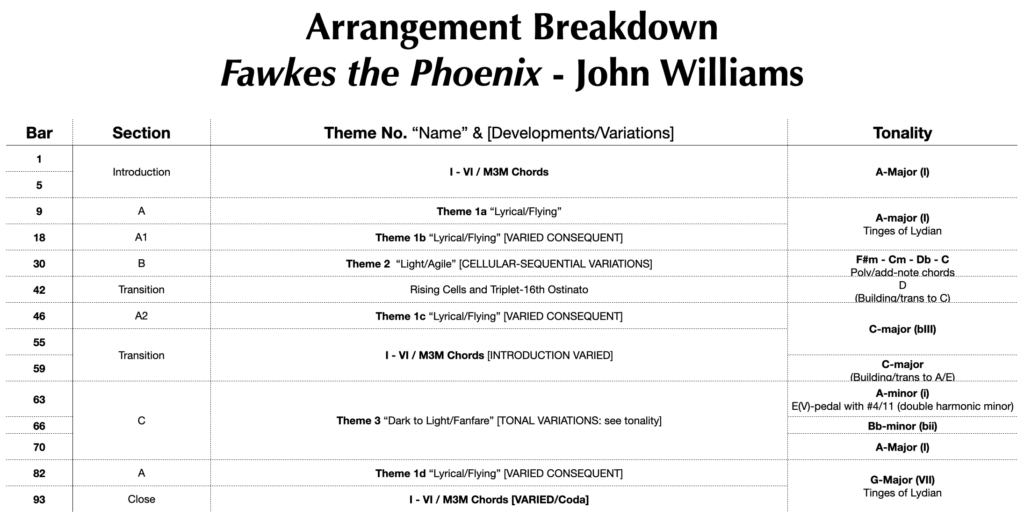
An analysis that looks at modality (modulation & interchange), pedal points and chord voicing in RVW’s The Lark Ascending.
The Melodies Exposed
There are three key melodies and a fourth smaller idea that reoccur across Williams’s Fawkes the Phoenix. How these are constructed and developed is something that we will discuss. However, their initial appearances are as follows (click headers to be taken to where they appear in the soundtrack):
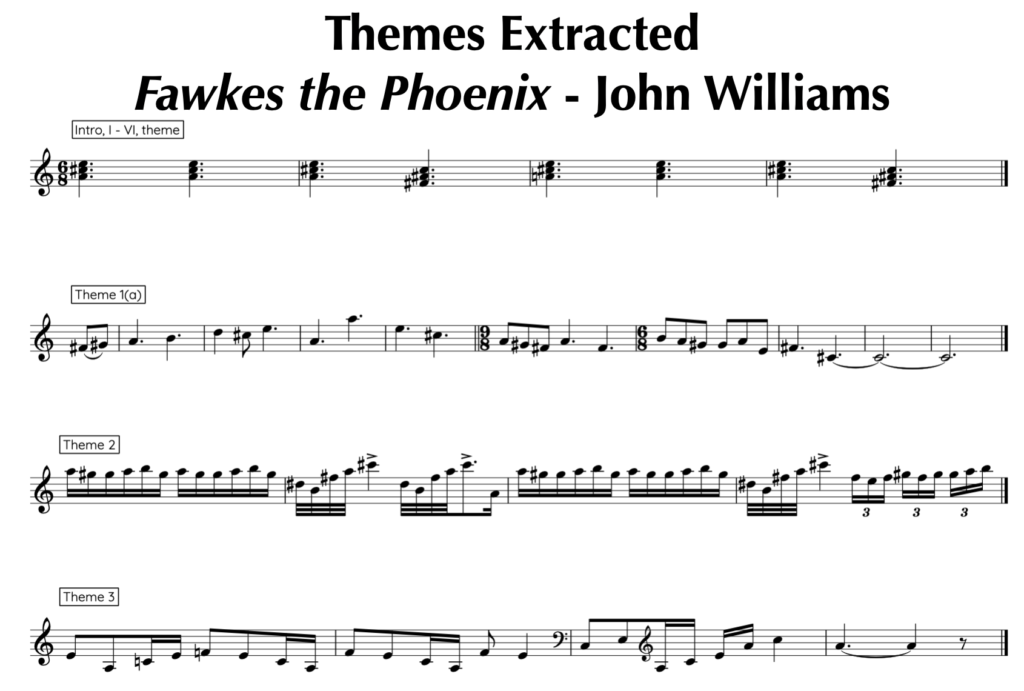
Theme 1
Theme 1 is the main melody of the arrangement, reoccurring as the A-section across the composition. A lyrical melody, it richly blends stepwise, skip and leaping intervals that, in my humble opinion, beautifully encapsulate the phoenix. It has broad qualities that capture the stately grace of what I imagine the bird to be, and what it is in the film and stories.
One feature I particularly like about this theme, in its wider orchestration, is the similar upward movement we get in the orchestral parts in the opening phrase. The harmony, an A (I) to B (II) progression implements an uplifting, bright, lydian quality as well. It feels like we are taking off, in flight, with the music.
Theme 2
Theme 2 from a more technical and structural counterpointing perspective reminds me of the second primary theme that we found in Williams’ cue from the first Star Wars: The Phantom Menace film, The Flag Parade.
Not quite so extreme as The Flag Parade, theme 2 here is also rhythmically lighter on its feet. Unlike theme 1, many of the downbeats are smaller note durations. The motif in the second bar of the extract, for example, accentuates the second and fifth beat division of the 6/8 bar. The effect of this is a sudden propulsion that would be less potent if it were anticipating a downbeat. Similar to how I described Theme 2 of The Flag Parade, it is like Williams is pulling the rug from underneath us, as a means of keeping us engrossed by counterpointing the measured, stately, quality of the first theme.
Theme 3
Theme 3 is a short, dark idea that is presented by horns. In the Hal Leonard arrangement it lists four horns, but I think the soundtrack likely used 6. Where the preceding two themes catch the floating grace of the phoenix, this theme catches fire.
I-VI/M3M (episodic) idea
The introductory idea that I label “I-VI” or “M3M” is a simple chordal idea that Williams often uses for more episodic periods such as the opening, ending and then transitioning. It sets the tone of the piece by juxtaposing a major tonic (I) chord with its major sub-mediant (VI) or a pair of major chords, signified by the two Ms of “M3M” that are separated by 3 semitones.
Its a striking juxtaposition of chords harmonically as the use of the major sub-mediant requires a sharpened 1st scale degree, or tonic note.
If you are enjoying this article, then you should consider subscribing to Any Old Music’s emailing list, to be notified when we release new and mailing list exclusive content (e.g. One Page Summaries and Creative Briefs etc.).
Tonality and Harmonic Structures
One broader way in which Williams varies his material, in Fawkes the Phoenix, is by modulating into different keys. Note how theme 1 is presented in different keys across the piece (see structural breakdown). First in A-major (I), then C-major (bIII) and then G-major (VII).
Along with tonality, Williams also varies the general harmonic structures, or complexity, that underpins each melody, adding further richness to the harmonic language. In theme 2, for example, Williams uses a number of polychordal, extended and added note structures, that complement theme 1s use of triadic harmonies. For example, the opening chord of theme 2, if we include the G# of the melody line, forms a chord comprising every note of our root A-major scale (or F# natural minor scale, which forms the root of the chord here).
The more complicated sonorities of theme 2 counterpoint the simpler triadic structures that accompany theme 1. For instance, barring some modal mixture, the harmony of theme 1 is straight forward. On a larger scale, the harmonies of theme 1 sections could be seen as providing a point of harmonic rest, in comparison to the complex and more dissonant structures of theme 2.
Regarding tonality again, Theme 3, presents a microcosmic display of direct modulations in which the melody is transposed and adapted to fit a tonal shift from A-minor to Bb-minor and then back to the parallel A-major.
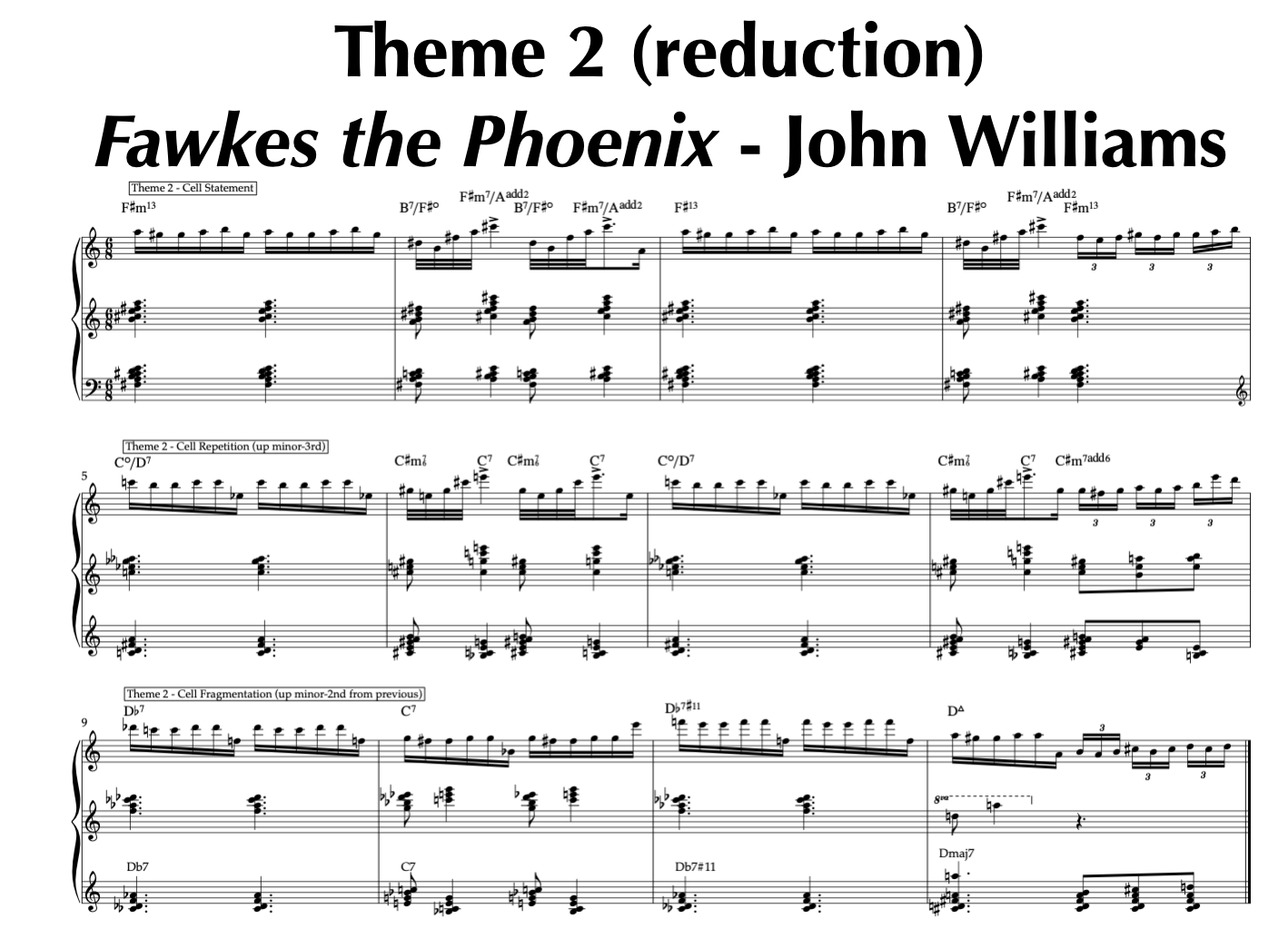
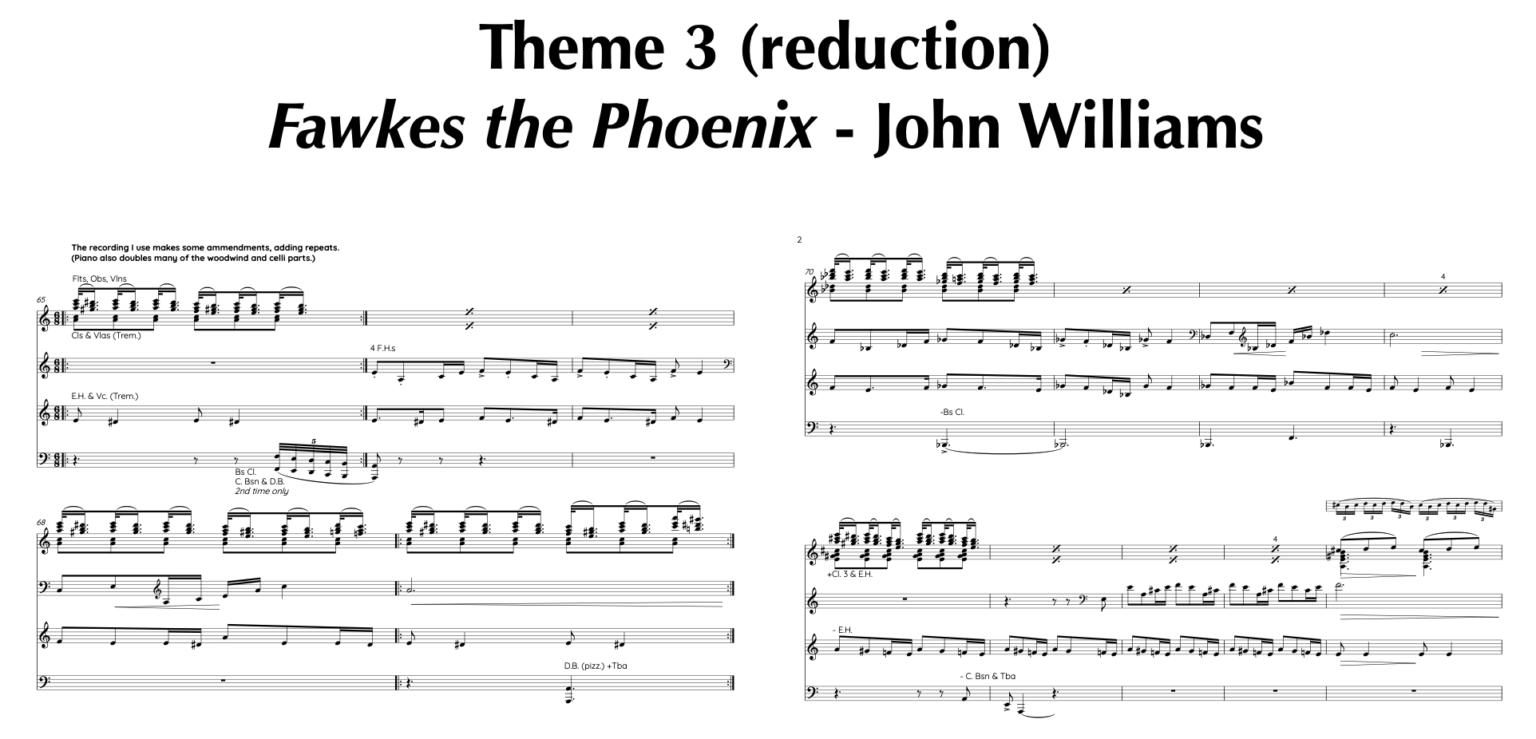
Melodic Development
Having looked at the overall arrangement and broader ways in which Williams varies his musical ideas, let’s take a closer look at how Williams varies his themes across the composition on a smaller scale. One way in which he does this is to alter the second part of his theme 1 melodies, what could be defined as the melodic consequents of these themes. The other way Williams extends his melodic ideas is through sequential adaptations and fragmentation, supplanting whole and parts of an idea onto a harmonic progression. Let’s take a look at each of these techniques, used in theme 1 and theme 2 respectively.
Theme 1: the varied consequent
The primary means by which Williams varies the main theme, theme 1, of Fawkes the Phoenix is by altering the consequent of the melody. If we look at the figure I have created, for example, we can see I have extracted what we would call the antecedent at the top and then several consequents below it. The antecedent and consequent are essentially two phrases of the melody, which complement one another, forming one whole. (I will link a video below, that discusses the concepts antecedent and consequent in focus.)
The consequent phrases are something of an answer to the antecedent phrase, and Williams, bar modulating and transposing the melody, keeps the antecedent the same each time. The consequents, on the other hand, he subtly varies. The advantage of this is that we get a consistent assertion of the main melody: we can clearly hear its return. However, the subtle variations give us something new, rather than straight repeats that could become tiresome.

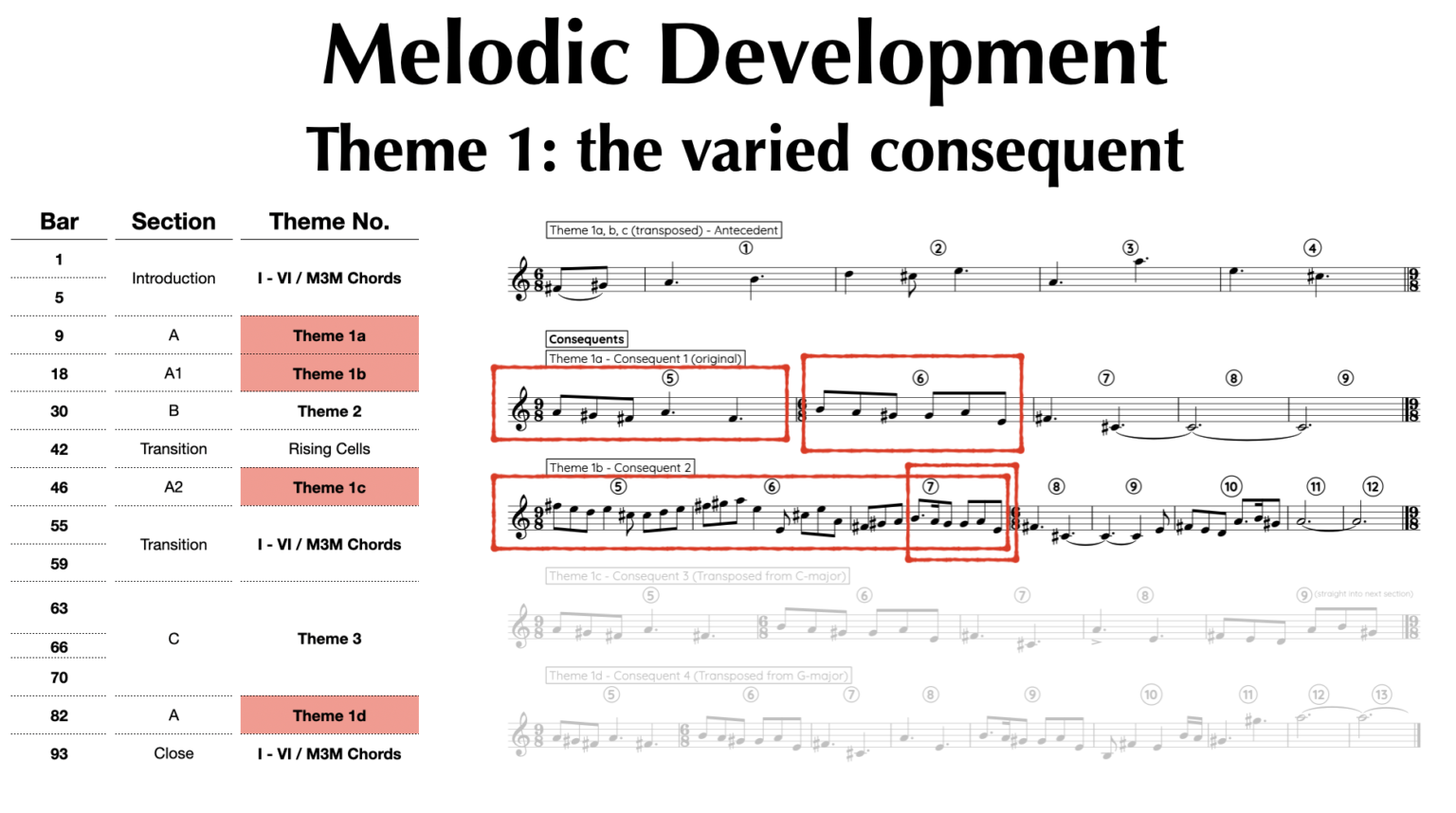

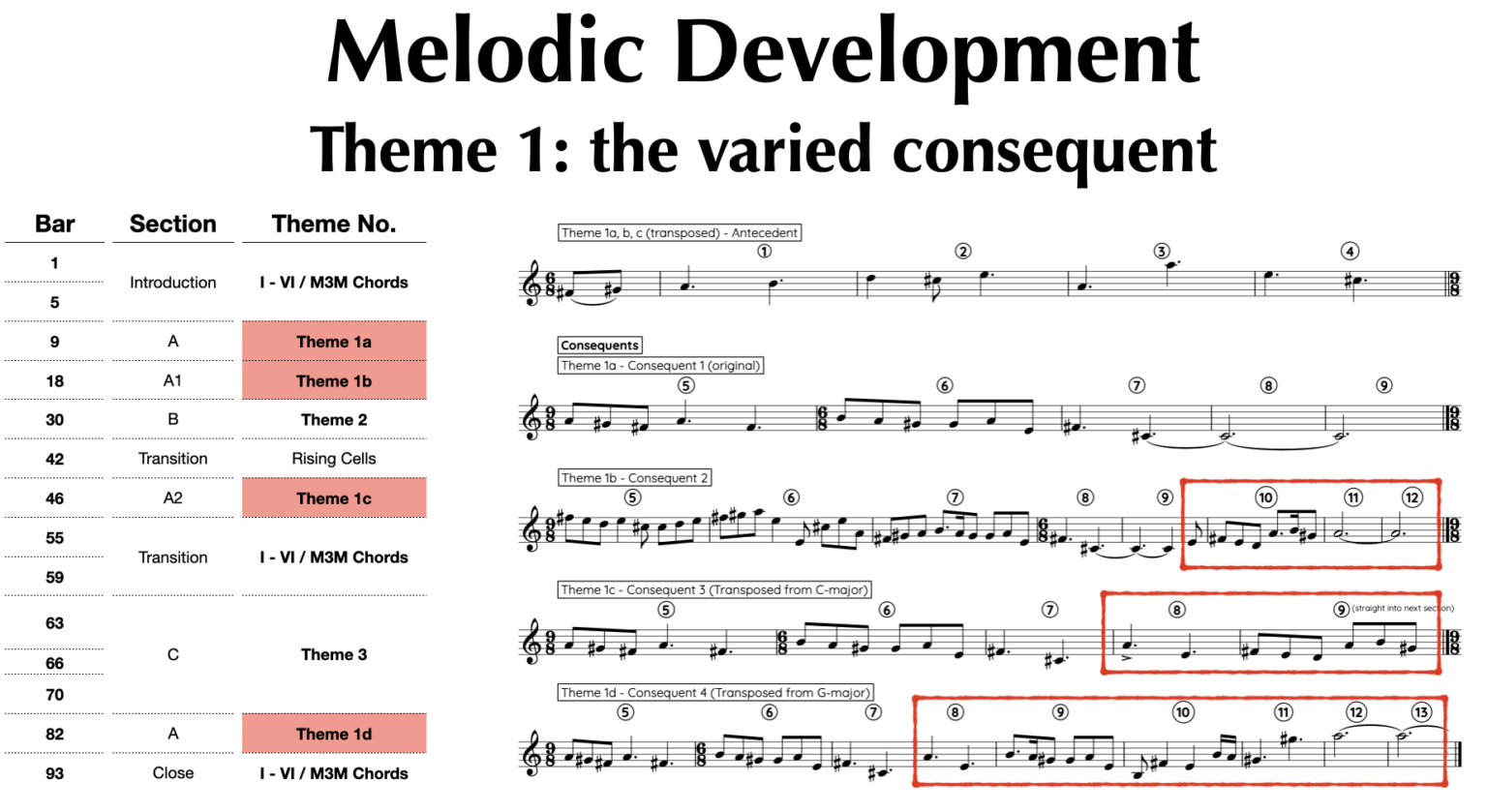
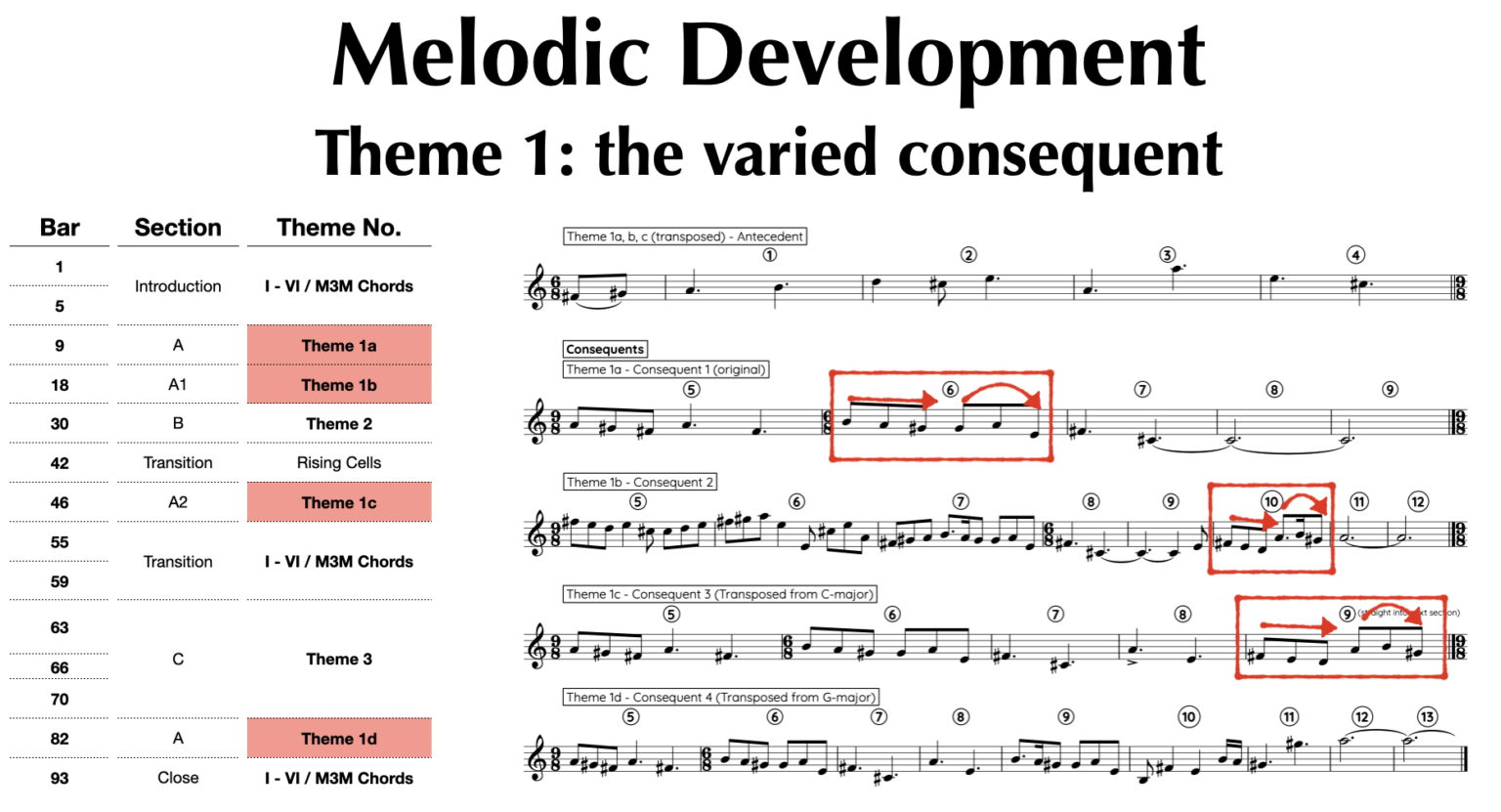
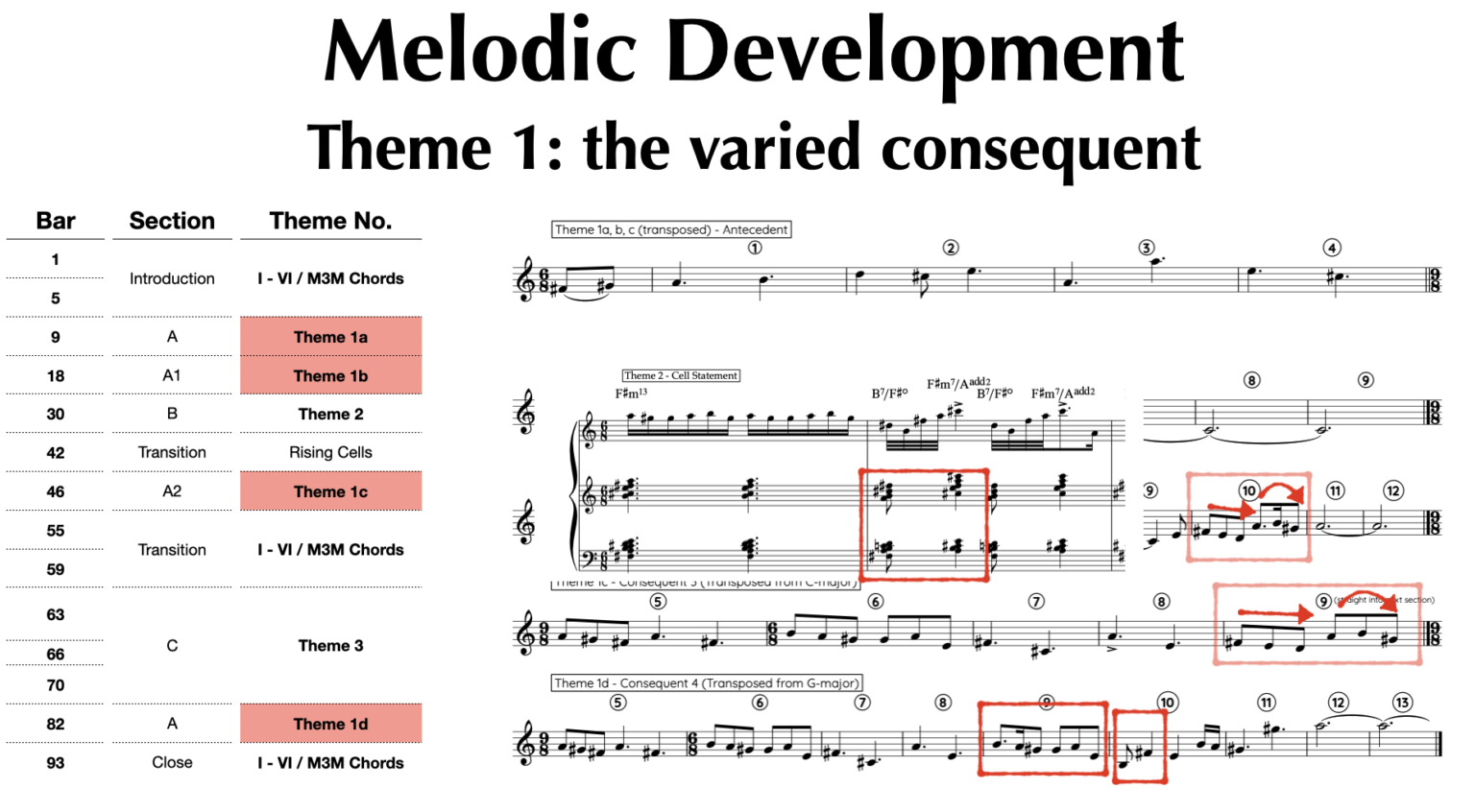
Consequent 1 vs 2
Comparing each of the consequent phrases, using the first as our “original”, we can see that the second consequent is the most changed. Perhaps a result of it being in the same key as theme 1a, Williams decided change elsewhere was needed? The most blatant distinction is the extension of the use of triple metre, which allows for an elaboration on bar 5 that extends through to the first beat of bar 7. The second beat of bar 7, as you can see is a subtle rhythmic variant of bar 6 in consequent 1.
The elaboration of bar 5, into 6, allows for a second ascent to the highpoint of the whole melody, the A. It also facilitates a second series of excitable leaps that bring renewed energy.
I’ll come back to the extensions of the phrase shortly.
Consequent 1 vs 3 & 4
The latter pair of consequents are more modest, if one excludes the transitional extension to consequent 4 for a moment. For example, the only change is a truncation of the phrase end. Where the original, consequent 1, rests on C# for several beats, consequents 3 and 4 rest only for a single beat before rising to the tonic and moving into the extended parts of the phrase.
Consequent 2, 3 & 4 extensions
Each of the consequents of the varied themes are extended. For consequents 2 and 3, the extension is similar, with both using a slight rhythmic variant of the same figure between 10 and 9 respectively.
These melodic moments, bar 10 in consequent 2 and bar 9 of consequent 3, are derived, in my opinion, from bar 6 of the original consequent. The first beats for instance both boast a figure that descends in stepwise motion, while the second beat features an ascending step followed by a leap or skip downwards. While different as wholes, the smaller units both boast great similarities.
Consequent 4 actually repeats the figure we have just being discussing in the rhythmically varied form that it appears in in bar 7, beat 2 and 3, of consequent 2. Its repetition is used to usher in a transition into the closing section of the piece. There are some similarities to earlier material in this extension. For example, the octave leap in bar 11, which features in the antecedent of theme 1. However, interestingly, the upward 5th in bar 10 is reminiscent of the chordal movement of theme 2 that ascended by a 4th.
Chopin Nocturne No. 20
The technique of varying and transitioning via melodic consequents is a valuable composition technique. It is also one that we have spotted before on this channel while looking at Chopin’s C#-minor Nocturne No. 20 (Op. posthumous). Repeating his own theme 1, in the outer sections of a ternary form, Chopin would often embellish and ornament his entire melodies. However, he also substituted the second part of his second use of theme 1, modulating to what I label as a move to F#-minor but is really the reverse: a move back to the tonic from the sub-dominant.
An analysis that looks at modality (modulation & interchange), pedal points and chord voicing in RVW’s The Lark Ascending.
Theme 2: Transposition, Sequence and Fragmentation
The other way in which Williams varies his melodic material, in Fawkes the Phoenix, is through the use of melodic sequencing and fragmentation. For example, if we take the opening two bars of theme 2, we can derive nearly all the following material of this section from them.
Bars 3 and 4, for instance, excluding the phrase ends, are a straight repetition of the opening idea.
Bars 5 to 8 are largely a sequential transposition of these opening bars. Not quite straight transpositions, they have been largely moved by a minor-3rd in bar 5 and a perfect-4th in bar 6. However, Williams bends and moulds them to suit the underlying harmony and melodic expectation brought about by those harmonies.
Bars 9 to 12, on the other hand, all take the motif of bar 1, of this extract, as a fragment that is transposed and morphed, like parts of bars 5 to 8, to fit the harmonic progression.
Displaying a great deal of economy, Williams is able to take essentially two beats of music: beat one of both bars 1 and 2 of the extracted Theme 2 and spread it across 12-bars. He does this, as we’ve just seen by transposing and altering the material to fit the harmonic progression that he needs and then also fragments the melody as a literal breakdown and transition out of the section.

Close
Unsurprisingly there is a great deal to learn from the Hollywood Grand Maestro. We have only really touched upon a handful of the musical devices that he uses in the piece, Fawkes the Phoenix. Returning to arrangement momentarily, for instance, and reflecting on that which we have glimpsed at in the way of harmonic and melodic forms and structures, Williams’ arrangement is a rich tapestry of contrasts and consistencies. Sections carry over ostinati, all the while the melody and harmonic landscape has changed and/or the mode of melodic development has shifted. Individually rudimentary devices in combination and as a whole, Williams wields them to create a rich, sophisticated potion.
10 points to House Williams.
If you have enjoyed this article, then you should consider subscribing to Any Old Music’s emailing list, to be notified when we release new and mailing list exclusive content (e.g. One Page Summaries and Creative Briefs etc.).




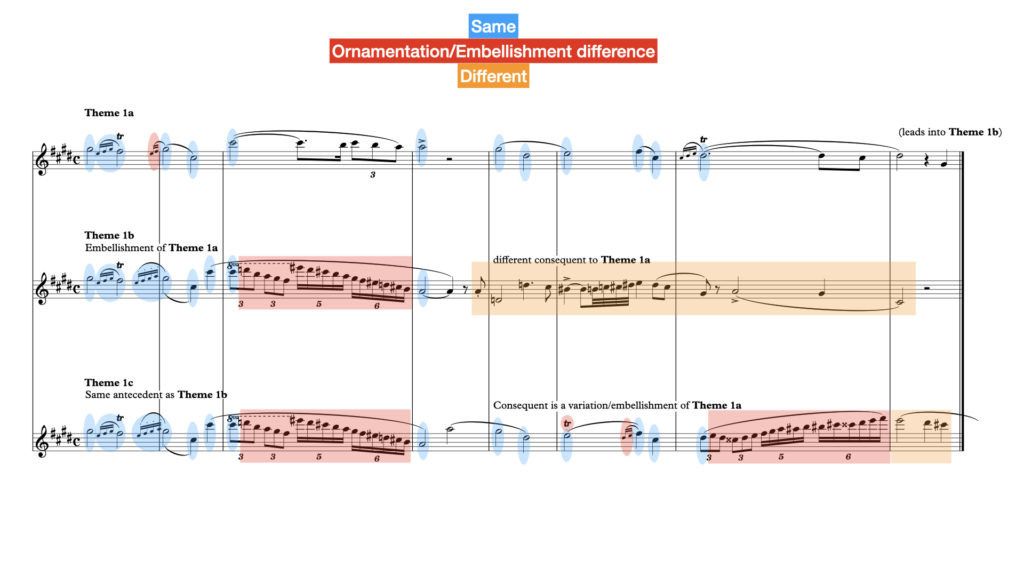
Pingback: Salut D'amour - Edward Elgar (Music Composition Technique Analysis) - Any Old Music